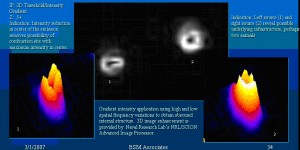After researching many accounts of “ghost lights” in various parts of the United States, I have found an obvious answer: Many of these lights are from hunting barn owls, the common Tyto Alba. But the glow of barn owls seems to be far from common, in fact shocking, for the answer involves an intrinsic bioluminescent.
According to the avian researcher Fred Silcock, of Austalia, at least some of these birds have the potential to glow, although it may not be used except in extreme need, in particular near-starvation. Glowing barn owls can catch insects when other prey is unavailable. That would explain why pet barn owls never glow: They are never starved.
The Ghost Light of Masters Knob (Johnson City, Tennessee) may be the bioluminescent glow of one or more barn owls, for it has been described as swinging back and forth as if someone were carrying a lantern. This resembles descriptions of strange flying lights in Australia, the Min Min lights researched by Silcock.
Other American ghost lights are not so easily explained away as hunting owls, such as the Marfa Lights of Texas and the Brown Mountain Lights of North Carolina. Especially intriguing are the Marfa Lights, for they sometimes appear to dance: Two lights separate, flying in opposite directions for a time, then they rush back together. This is not at all typical barn owl behavior, notwithstanding those birds often hunt in pairs.
Ghost lights that appear to move intelligently, yet not according to barn owl traditions—those lights can be explained in many ways, most of them inadequately. The most likely explanation for Marfa Lights is a group of intrinsically bioluminescent flying organisms, much larger than fireflies, perhaps even larger than barn owls. Less-likely are they UFO’s, ball lightning, dancing demons, ghosts, or atmospheric conditions. From my interviews and other experiences, I estimate that the probabilities of correct interpretation of Marfa Lights are these: living nocturnal pterosaurs (perhaps similar to ropens of Papua New Guinea)=75%; unknown living organism=10%; barn owls=8%; misc (UFO’s, ball lightning, demons, ghosts, atmospheric conditions, etc)=7%.
###
The missile defense physicist Clifford Paiva analyzed video footage of two flying lights (maybe modern bioluminescent pterosaurs). He concluded that common explanations (non-pterodactyl) had been eliminated. No other explanation made sense, among the many speculations possible for the flying lights in Papua New Guinea. The lights were not from meteors, airplanes, car headlights, camp fires, or any other commonplace things. He also eliminated a hoax, noting such things as three-dimensional consistency and distant-blurring consistent with atmospheric distortion.
 One image from the unpublished scientific paper by Clifford Paiva
One image from the unpublished scientific paper by Clifford Paiva
.




From what I read in a book by James Bunnell, he does not believe that barn owls have anything to do with Marfa Lights. But he did not read much about the Min Min Lights of Australia, it seems to me. He specializes in the Marfa Lights of Texas.
But the ropen light of Papua New Guinea, if the natives are correct, sometimes drips or drops pieces or drops of glowing stuff. It seems to me that this may be like the little “pebble” thing that was left by one of the Marfa Lights. This little glowing thing was picked up by a minister or somebody with a church group one night. The little thing kept on glowing for awhile before it dissappeared or evaporated. This is like the ropen light that is said to be a live pterosaur.
This needs more explaining, or it will seem too weird. For many years, a few Americans have been going to islands north of Australia, in the country of Papua New Guinea. They have gathered information, mostly from interviewing natives, sometimes from videotaping such as the Paul Nation video of indava lights in 2006. In 2007, Destination Truth also videotaped a similar light in Papua New Guinea.
Natives in many places, with different languages and different cultures tell Americans about what makes the flying lights. They talk about large flying animals. Some natives have seen them in the daytime and talk about them having no feathers but long tails. The natives know that this animal is not a large bat. It is some Americans who have a problem with wanting to believe that these big flying animals are fruit bats. But the fruit bats do not eat fish and they do not have long tails. Those are some of the reasons some of us believe that the ropen and indava are live pterosaurs (the correct technical term for pterodactyl). There is no bat living or extinct that was like a giant long-tailed pterosaur.